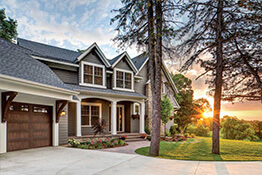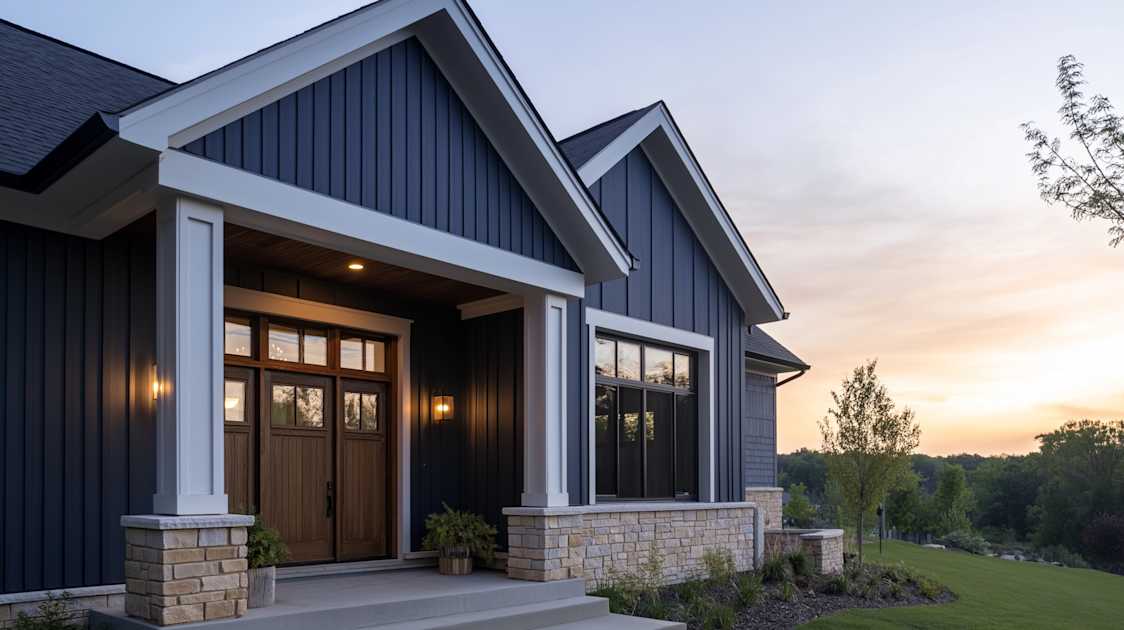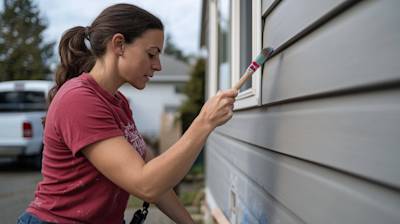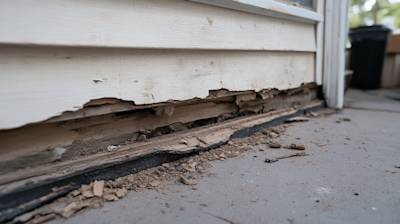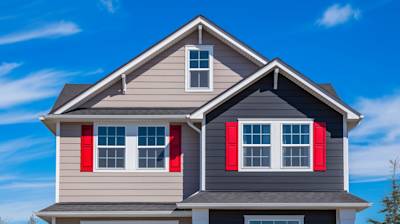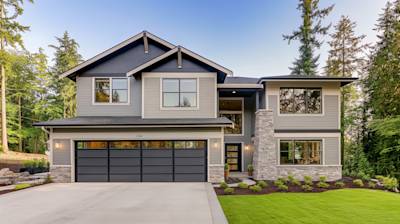If you're planning a home renovation project or a new construction, the exterior of your home is one part you shouldn't overlook. As you ponder the visual appeal and protection of your home, you might be considering vertical siding. Best known for its dramatic aesthetic impact and its ability to protect from harsh weather conditions, vertical siding is gaining popularity among homeowners, contractors and architects. This article digs deep into vertical siding, understanding its concept, types, installation, maintenance, and associated costs.
The Ins and Outs of Vertical Siding
Vertical siding, also known as board and batten siding, is an exterior finish installed vertically to a property where the siding boards are laid tall and the battens are the cover placed over the joints. It's a versatile and attractive option that suits a broad range of architectural styles. Whether it is for a contemporary urban home, a rustic cabin, or a traditional country home, vertical siding offers differentiation with texture and shadow lining to bring out the character of any dwelling.
Types of Vertical Siding
Vertical siding comes in a variety of materials. The ideal choice ultimately depends on your aesthetics preference, the climate where you reside, and your budget. Below are some of the most common types:
-
Vinyl Vertical Siding: Affordable, low-maintenance, and available in numerous colors.
-
Metal Vertical Siding: Durable and robust, excellent for commercial properties.
-
Wood Vertical Siding: Offers a classic and natural appearance, but requires more regular maintenance.
-
Fiber Cement Vertical Siding: Mimic any material, robust and lower maintenance than wood.
The Proper Installation of Vertical Siding
Whether you're a DIY enthusiast looking to install vertical siding yourself or you're hiring professionals, proper installation of vertical siding is essential to ensuring its longevity and functionality. The siding should be attached securely to prevent damage from strong winds, and the joints should be sealed adequately to prevent water infiltration.
Vertical Siding Maintenance
Maintaining vertical siding is straightforward, especially if you've opted for a low-maintenance material such as vinyl or fiber cement. However, regular inspections are still vital to ensure that your siding is in top-notch condition. Monitor for signs of damage, like cracking, splitting or warping. These should be addressed promptly to prevent more costly issues down the line.
The Cost of Vertical Siding
The cost of vertical siding can vary considerably based on the material chosen and the size of your property. High-end materials like wood or metal can be more costly compared to vinyl or fiber-cement siding. Remember, while initial cost is an essential consideration, you should also consider long-term maintenance expenses. For example, wood may be more expensive upfront and require more regular maintenance, but many homeowners feel the aesthetic appeal is worth the investment.
Eco-Friendliness and Energy Efficiency of Vertical Siding
Many homeowners are now looking for eco-friendly and energy-efficient options when choosing siding materials. The good news is that many vertical siding options are environmentally friendly, especially if you opt for sustainable materials like commonly recycled metals or woods from responsibly harvested forests. Additionally, proper siding installation can contribute to your home's overall energy efficiency, reducing heating and cooling costs.
Vertical siding is more than just an aesthetic feature – it's a vital component that protects, insulates, and ultimately enhances the value of your home. It's a long-term investment that comes with many advantages, from durability and the property's stunning aesthetics to improved energy efficiency. Ensure you study the unique characteristics of each material option, and choose the one that best suits your style preferences, climate, and budget.
Frequently Asked Questions About Vertical Siding
Why should I consider vertical siding for my home?
Vertical siding presents an appealing alternative to the usual horizontal siding due to its distinctive aesthetics. Vertical lines can add a touch of modernity and elegance to your home, enhancing its curb appeal. It's also often more durable against harsh weather conditions and, due to its orientation, it's less likely to accumulate dirt and debris.
What are the different types of vertical siding?
There are several types of vertical siding available on the market. Common types include board and batten, tongue and groove, and channel. There are also numerous material options available, such as vinyl, wood, metal, fiber cement, and more. Each type and material has its own unique characteristics and benefits.
How is vertical siding installed?
The process of installing vertical siding involves several steps. To start, furring strips are nailed to the exterior walls vertically before the siding is installed. These strips provide the backing needed for the siding. After these are in place, the siding panels are then nailed down perpendicularly. The process is overall more labor-intensive than installing horizontal siding.
How much does vertical siding cost?
The cost of vertical siding can vary greatly depending on the material you choose, the size and complexity of your home, and whether you're installing it yourself or hiring a professional. For instance, vinyl is usually the most affordable option, while materials like cedar and fiber cement tend to be more expensive.
How do I maintain my vertical siding?
Maintaining your vertical siding is relatively simple and involves occasional cleaning to remove dust, dirt, and mildew. You can use a pressure washer to do this. Also, it's a good idea to check for any signs of damage or wear regularly. If your siding is made of wood, it will require painting or staining every few years to keep it looking its best.
Does vertical siding offer good insulation?
Yes, just like horizontal siding, vertical siding also offers good insulation. The degree of insulation mainly depends on the material used. For instance, insulated vinyl siding is energy efficient and can significantly reduce your heating and cooling costs.
Can I install vertical siding over my existing siding?
In most cases, you can install vertical siding over existing siding, provided the current material is in good shape and has a flat surface. Doing this could save you the expenses and hassle of removing the old siding. However, it's essential to consult a professional to make sure.
How does vertical siding fare in severe weather conditions?
Depending on the material, vertical siding can withstand a variety of weather conditions. For example, vinyl and metal siding are highly resistant to moisture and will not warp or rot. Wood siding, on the other hand, needs regular maintenance to prevent weather-related damages.
Is vertical siding popular for commercial buildings?
Yes, vertical siding is particularly popular for commercial buildings. In addition to the aesthetic benefits mentioned earlier, vertical siding can provide excellent durability and flexibility, making it an ideal choice for commercial applications.
Should I hire a professional for vertical siding installation?
While do-it-yourself installation is possible, it's generally recommended to hire a professional to install your vertical siding. This is due to the complexity of the installation process, plus a professional can ensure your siding is installed correctly and efficiently, avoiding potential costly errors down the line.
Pros and Cons of Vertical Siding
Pros of Vertical Siding
Enhanced Water Runoff
One of the major benefits of vertical siding is the enhanced water runoff. Unlike horizontal siding options where water can potentially seep into sidings and cause damage over time:
-
Vertical siding aids in the smooth flow of water, reducing the risk of water penetration or build-up.
-
This makes vertical siding a popular choice in regions with heavy or prolonged rain spells, and adds to its durability.
Unique Aesthetic Appeal
Vertical siding offers a unique aesthetic appeal that differentiates it from traditional sidings:
-
The vertical pattern can add height and elegance to a home's exterior, making it appear taller.
-
It also offers a lot of design flexibility, allowing for incorporation of other design elements such as stonework or brick for a more customized aesthetic appeal.
Low Maintenance
Vertical siding is generally low maintenance:
-
The ease of painting and cleaning vertical siding surpasses that of horizontal siding.
-
The long, vertical lines can be easily wiped down without the need for ladders or extensive scrubbing.
Cons of Vertical Siding
Cost
One of the top disadvantages of vertical siding is the potential cost.:
-
Installation of vertical siding is often more labor-intensive than horizontal siding, leading to higher labor costs.
-
While not always the case, the actual material costs can also be higher, dependent on the type of vertical siding chosen.
Installation Challenges
Vertical siding comes with its own set of installation challenges:
-
Because of the vertical orientation, installation requires more precision to ensure that the siding is correctly aligned from top to bottom.
-
This can make the process trickier and more time consuming, which could potentially lead to increased labor costs.
Vulnerable to Pest Invasion
While vertical siding provides greater water runoff, it can potentially be more vulnerable to pest invasion:
-
Certain pests, like insects or woodpeckers, may find it easier to burrow into or damage the vertical orientation of the siding.
-
Choosing pest-resistant materials can help mitigate this risk, but it is something to consider when comparing siding options.
Increased Need for Insulation
With vertical siding, there may be an increased need for insulation:
-
Due to the vertical alignment of the siding, there can be larger gaps left between siding pieces.
-
These gaps can increase the chance of heat loss, making insulation a necessary part of the installation process.
Summary
When it comes to enhancing the aesthetic value of your home, vertical siding is a fantastic option. With its rich textures and unique visual appeal, it can add a striking touch to any house. This type of siding is not only trendy but also offers a high level of durability and ability to withstand extreme weather conditions, making them a worthy investment for homeowners.
Still, the benefits of vertical siding don't stop at looks and durability. From a practical standpoint, it can help with water drainage and is often easier to install due to its unique orientation. Simple cleaning and maintenance procedures are enough to retain its fabulous look for years, offering an easy and attractive option for homeowners wanting a different look for their home exterior.
So, if you're looking to give your house a quick refresh or planning for a complete makeover, don't overlook the potential of vertical siding. It offers a multiple-benefit solution, combining stunning aesthetics with practicality and strength. The decision to choose vertical siding could prove to be one of the best decisions you could make for your home renovation, one that you will be pleased with for years to come.
About US Quality Construction of Columbus
Welcome to US Quality Construction of Columbus, your number one partner in all your construction needs. Hailing from Columbus, OH, we are proud to bring high-quality workmanship to every project we handle. Our commitment to exceptional service and uncompromising quality sets us apart in the industry. Whether you're embarking on a residential or commercial project, our seasoned team is ready to use their expertise and dedicated approach to bring your visions to reality.
Tags: Vertical Siding, Home Exterior, Siding Options,
